Similar Posts
The Archbishop Dmitri Memorial Chapel is an ongoing project at St. Seraphim Cathedral in Dallas, Texas. It is especially interesting as it is a chapel designed to honor the earthly remains of the locally venerated archbishop. We are pleased to offer this interview with master iconographer Vladimir Grygorenko, who designed and painted the chapel.
A. Gould: How did the idea for a memorial chapel come about?
V. Grygorenko: It was obvious to everyone at St. Seraphim Cathedral that Archbishop +Dmitri should be buried near the church that he founded in 1954. Unfortunately, the city code allows such burials only under the foundation of pre-existing church buildings. Since St. Seraphim was built upon a number of piers, and it was impossible to fit an underground burial chamber between them, the idea to build a chapel adjacent to the cathedral was the first that came to my mind. We started to develop a plan right after his departure… Because it was impossible to build anything before his burial, it had been decided that Vladika’s earthly remains would temporarily stay at Restland Cemetery.
A. Gould: How much role did you have in designing the structure of the chapel? What were you trying to achieve, artistically, with this simple barrel-vaulted form?
V. Grygorenko: In this project, God blessed me with the wonderful opportunity to do almost everything: from the architectural design and construction supervision to the murals and iconography. I made the first sketch at the memorial supper, a few hours after Vladika’s burial. Metropolitan Jonah blessed it right away. The final design of a much bigger memorial complex, including a chapel and bell tower, was completed in 2013, together with Mr. Nick Unich, ASA.
I had several problems to solve. First, the exterior of the new addition should match the existing cathedral, which resembles Russian church architecture. Second, the interior of this rather small space should allow for a close and intimate relationship with the services, which will be conducted there, and with the Archbishop himself, who will be buried there someday.
I think the chapel’s form with barrel vault fits here perfectly. Designing the chapel, I have always kept in mind the murals which I would eventually put on its walls and ceiling. I cannot say that whole composition was developed in detail from the beginning. In fact I have changed it several times during the process, but the main idea, “The Last Judgment” scene remained intact.
There were also a few technical difficulties, such as the fire-lane setback for example, which were limiting my choice of solutions, but in general, I am satisfied with the result. With this addition we have enlarged St. Seraphim by about 30% of its size.
A. Gould: What is the liturgical function of the chapel? What types of services will take place there?
V. Grygorenko: Liturgically, the chapel will play several important roles. First of all, we are going to celebrate the weekday Divine Liturgy there. Not many parishioners can attend these services for obvious reasons – normally we have no more than thirty people in attendance, so they all will be comfortable in the chapel. It should provide rather unique experience for everyone – being so close to the altar, united in prayer…
As you can see from pictures, there is no iconostasis of any kind in the chapel, just two main panel icons on the sides. We did have a similar experience about five years ago, when, by the blessing of Archbishop Dmitri, we have served weekday Liturgy in St. Seraphim on the small altar table at the side of the cathedral. It was wonderful. Now, when Vladika will be brought home, we will celebrate liturgy in his presence.
According to our design (and city regulations) Vladika’s body will be buried in the underground chamber, six feet under the floor, in the center of the chapel. There will be a simple gravestone, made of the same white Calacatta marble as you see on the pictures, with his name carved on it.
Instead of a monument, there will be a marble icon stand with the icon placed in the center of the Chapel, approximately directly over Vladika’s head below, so everyone will be able to greet him on their way to the cathedral.
In addition, we are going to use the chapel for baptisms, so our baptismal font will be moved next to the Archbishop’s grave during these events. The very fact that the baptism is conducted in the chapel, devoted to the Last Judgment, will stress the eschatological aspect of that mystery.
A. Gould: Tell us about the iconographic scheme. How did you organize the subject matter?
V. Grygorenko: The chapel will serve as the place of eternal rest for Archbishop Dmitri – the place where he will wait until the Second Coming. That very idea defined the choice of the iconographic scheme, which illustrates Chapter 4 of the Book of Revelation.
On the East wall you can see an image of Christ in Glory, coming surrounded by four mystical Creatures – Eagle, Lion, Calf and Angel. The Glory of God, red, as made of heavenly fire, rests upon the small altar niche, surrounded by seven lamps, which are the seven Spirits of God (Rev. 4:5). The east and west walls are covered by images of twenty-four elders in white garments, sitting on their thrones (Rev. 4:4). Here, I follow ancient tradition, which associates these elders with apostles. Their garments are not of white color, but rather full of light to the point that colors are washed away. The apostles are looking toward Christ and each other, piercing the main volume of the chapel with their looks and involving observers into their prayer.
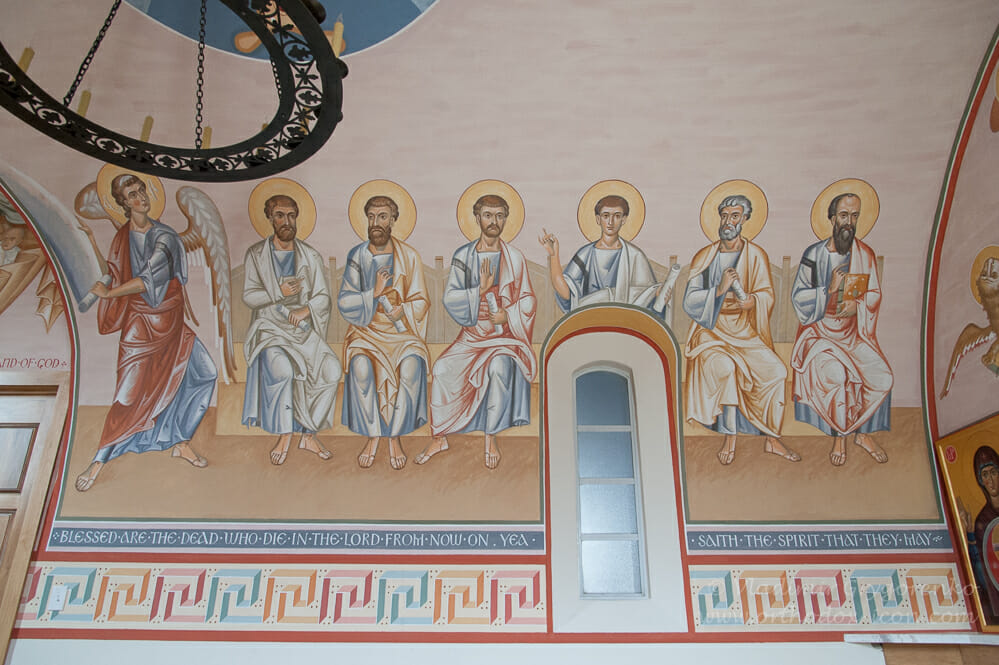 On the western part of the north wall one can see the figure of the angel who “rolled Heaven as a scroll” (Isaiah 34:4). Behind him, on the arch over the door, you can see another angel who takes the souls of the righteous to meet Christ. This is an illustration of the verse from Wisdom of Solomon 3:1, “Souls of the righteous are in the hand of God”, which is written above the door.
On the western part of the north wall one can see the figure of the angel who “rolled Heaven as a scroll” (Isaiah 34:4). Behind him, on the arch over the door, you can see another angel who takes the souls of the righteous to meet Christ. This is an illustration of the verse from Wisdom of Solomon 3:1, “Souls of the righteous are in the hand of God”, which is written above the door.
The image on the west wall depicts New Jerusalem and all departed who are waking up by the trumpet of an angel (in the corner). They are stepping out from their tombs and coming to meet Christ, their King and Savior. In this procession, led by the Theotokos and St John the Baptist, we can see St. Seraphim of Sarov, the patron of our church, as well as Archbishop Dmitri of Dallas.
Traditionally, inscriptions play an important role in iconography. There are two scripture verses on the grey band, which goes around the Chapel: “Blessed are the dead who die in the Lord from now on. Yes, says the Spirit, that they may rest from their labors, and their works follow them.” (Rev. 14:13) And: “Behold, the tabernacle of God is with men, and He will dwell with them, and they shall be His people. God Himself will be with them and be their God.”(Rev. 21:3)
A. Gould: I see that the image of Archbishop Dmitri has a halo around his head. Is it appropriate that a person who has not been canonized be depicted in that way?
V. Grygorenko: Well, a halo, by itself, does not mean that the person has been glorified. Only the inscription “Saint” or “Blessed” is required to make that conclusion. There are plenty of ancient images, especially murals and mosaics, where people who had not been canonized are depicted with nimbus or halo. As you probably remember, according to ancient Tradition, every Christian soul who died in peace with the Lord can be asked in prayer for intercession and therefore can be considered a Saint. Even more – Vladika… I know more than a few people (myself included) who experienced his intercession. In addition, there is such a thing as “local veneration” – a first (and required!) step to veneration by the Church as a whole. And finally, here the Archbishop is depicted in the context of the Second Coming, meeting Christ whom he loved and preached all his earthly life. I think that is fully appropriate.
A. Gould: And what can you say about the style of the painting, with the pale backgrounds? Is there Romanesque influence here?
Grygorenko: Romanesque? – Not exactly. While it is true that the Apocalypse/Last Judgment is a very well developed theme in Roman art, and Romanesque murals often had light pale backgrounds, I must say, that the Romanesque understanding of space and shape is slightly different.
I never try to imitate any historical “style” of iconography – I believe it to be counterproductive. At the same time, designing this chapel I extensively studied Roman and Pre-Iconoclastic images – a time where eastern and western art share common roots.
The light-purple background in the chapel symbolizes early morning of the New Era, the dawn of new creation: “Here, I make all things anew…” In the practical sense, a dark blue background, which is common for many contemporary church buildings, while adding some “drama,” would be inappropriate or even oppressive for such a small space.
A. Gould: You used KEIM plaster and silicate paints on this chapel. What would you say are the advantages of this system compared to your earlier work in the cathedral itself?
V. Grygorenko: KEIM silicate paints gave me an opportunity to create murals that look and feel like traditional fresco. This is important when you work in such a small space, where people cannot only see images but also touch them. Then, every detail will work for the main goal – to create an authentic and prayerful experience.
Unlike acrylic painting on canvas, which can be glued onto a surface like wallpaper, KEIM silicate murals must be done directly on walls. This helps the artist to adjust the composition and colors according to the real light conditions of a particular space, which, in turn, benefits its appearance. And finally, KEIM silicate is an extremely durable indoor and outdoor material, which greatly surpasses everything available on the market today. Unfortunately, KEIM was not available in the U.S. in 2001 when I started the murals in St. Seraphim Cathedral. That is why I had to go through quite a complicated process in order to make my murals there resemble the look of traditional fresco.
A. Gould: Is there any particular detail in this project that is a favorite of yours?
V. Grygorenko: The whole project was very important and uplifting to me. To some extent, it is a milestone in my career as an iconographer. It is also the tribute to my spiritual father, the founder of St. Seraphim Parish and whole Diocese of the South, and finally, an important person to all American Orthodoxy. Church art is always complex, and includes every aspect of murals, icons, design and craftsmanship. I cannot say that there is any particular detail in my work I would prefer to others. On the other hand, the hand-made chandelier you created for the chapel fits here perfectly and looks very authentic – we appreciate your work.
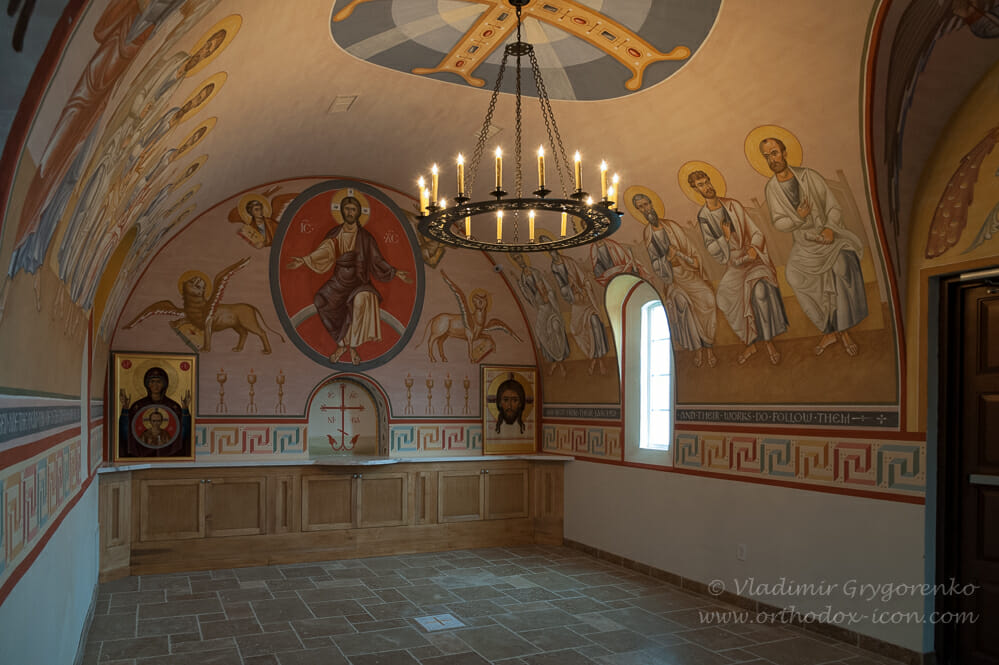
The iron chandelier manufactured by Andrew Gould incorporates an ornamental band specified by Vladimir Grygorenko. Low-wattage mini-candelabra bulbs give a light similar to candlelight.
A. Gould: Vladika Dmitri was especially dear to you personally, I believe. How did this relationship affect your work on this project?
V. Grygorenko: Vladika Dmitri was not only my spiritual father and archbishop, who made me a subdeacon, but also the person who influenced lives of thousands of people throughout all of the United States. He achieved that not by his orders, but rather by the example of his life.
To build this chapel for him is not another iconography commission, but an honor. I did feel his presence every day I worked there – and this helped me to do my work better.
My goal was to create the interior he would like, which would represent his generous personality and his spiritual will. I remember how, after every confession I made to him, he always told me: “Look at Christ Himself – always follow Him. He is the only source of our salvation…” That is why the main image on the east wall is the image of Christ in Glory, with bright red color that dominates the interior. Images of the Theotokos and St. John the Baptist, which are often placed near Him in historic images, have been moved to the west wall to stress that unique role of Christ.

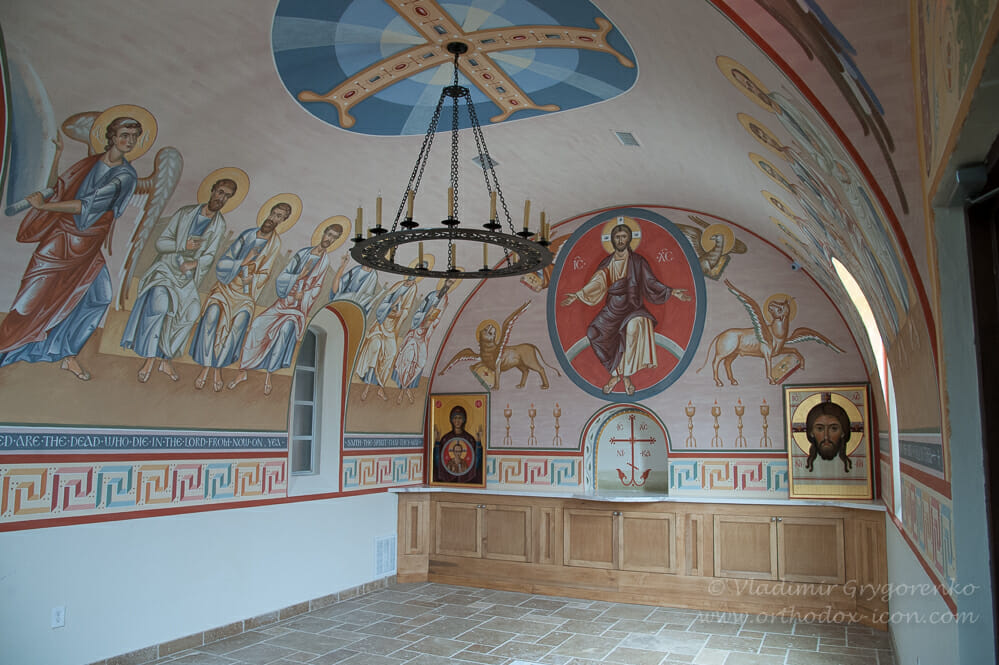
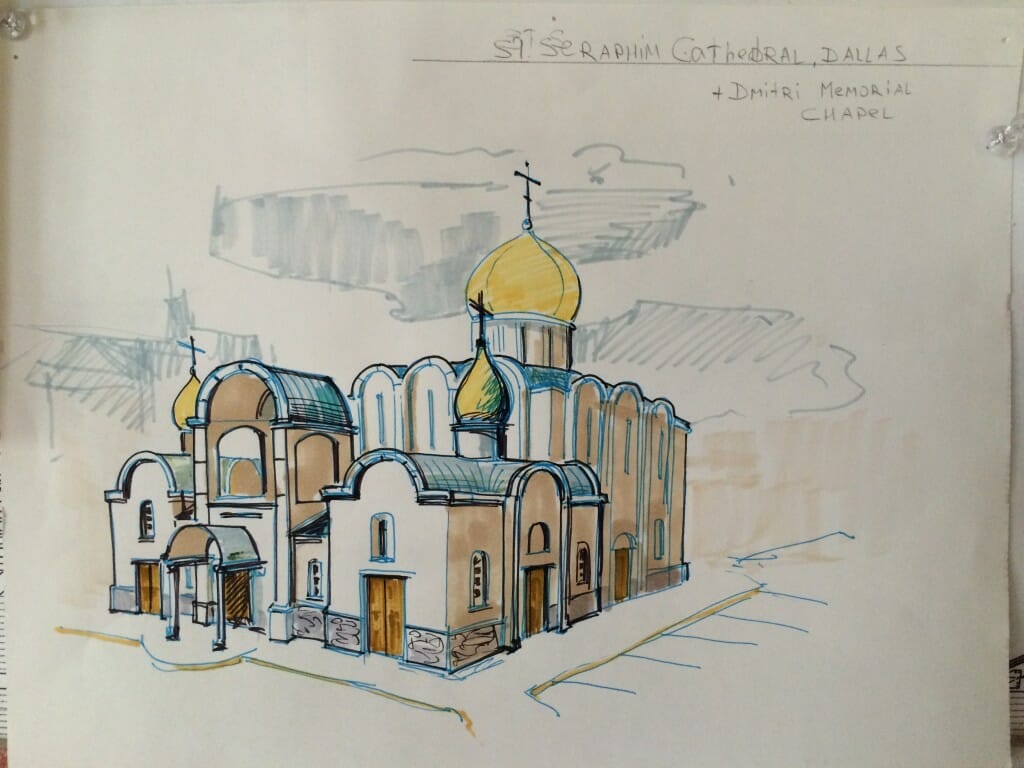
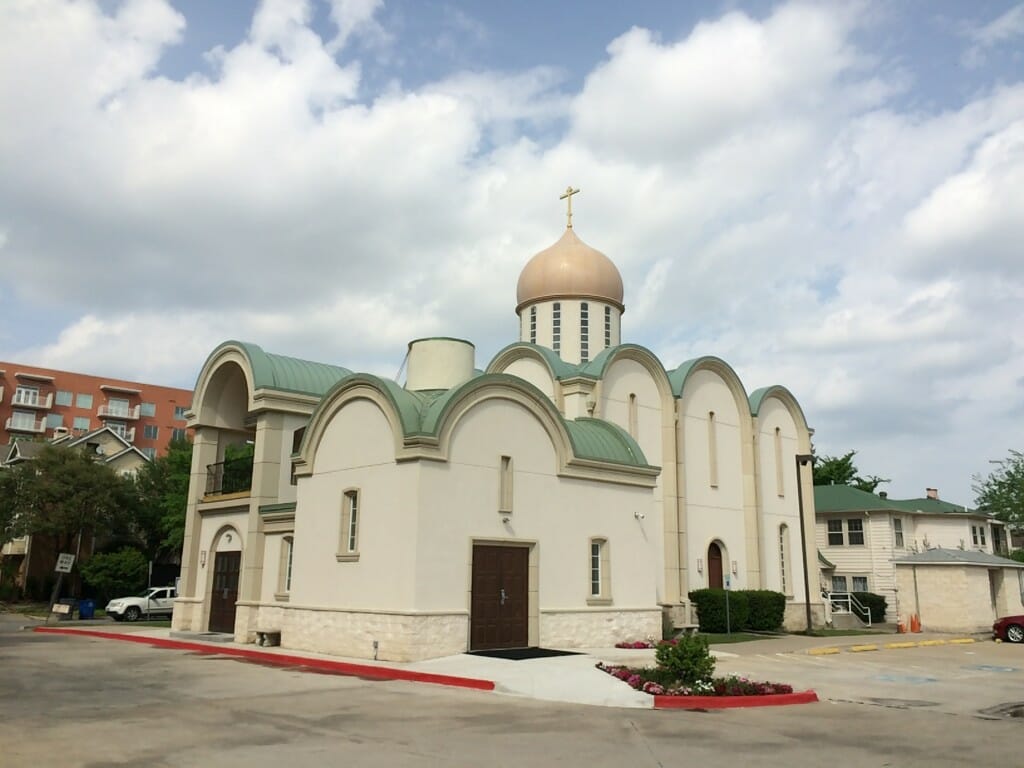
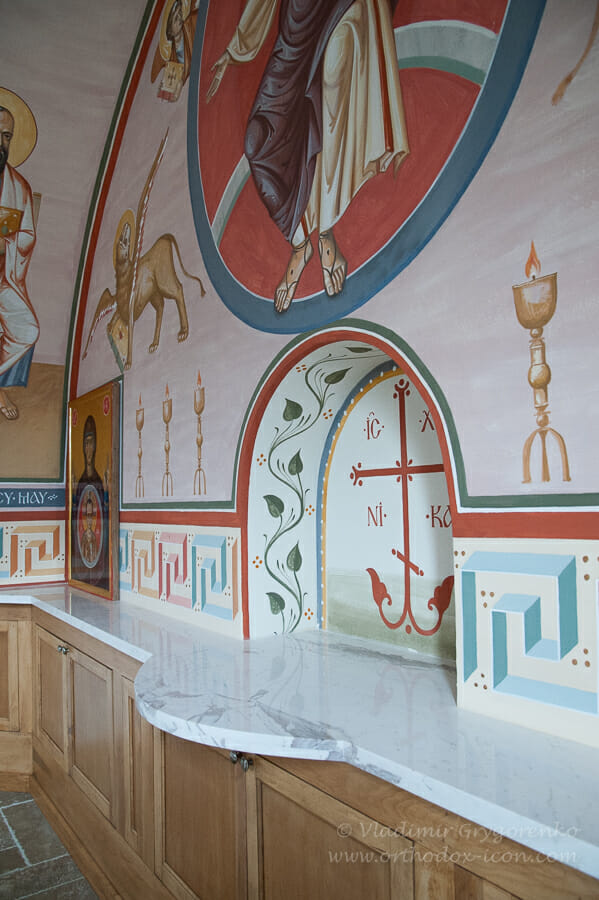
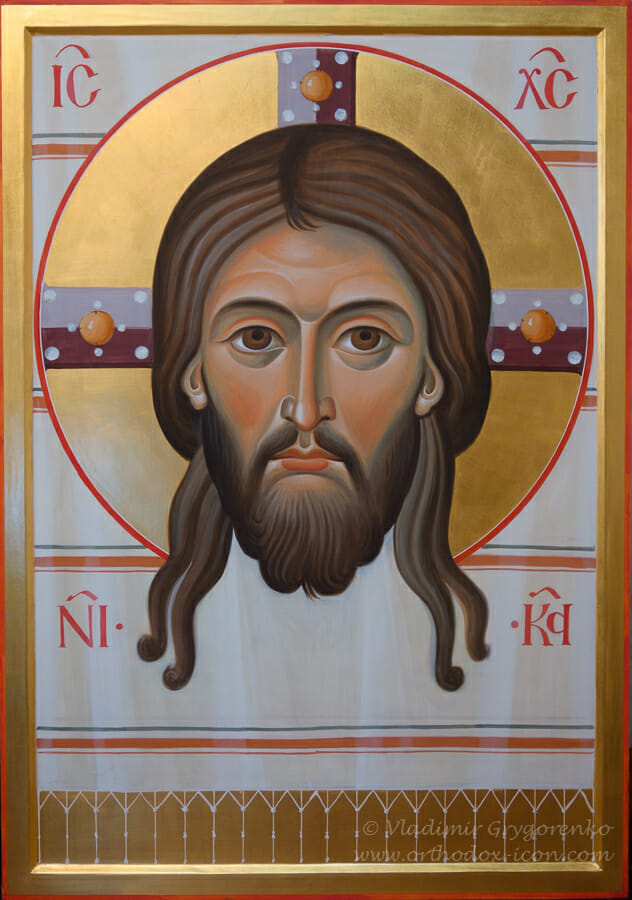
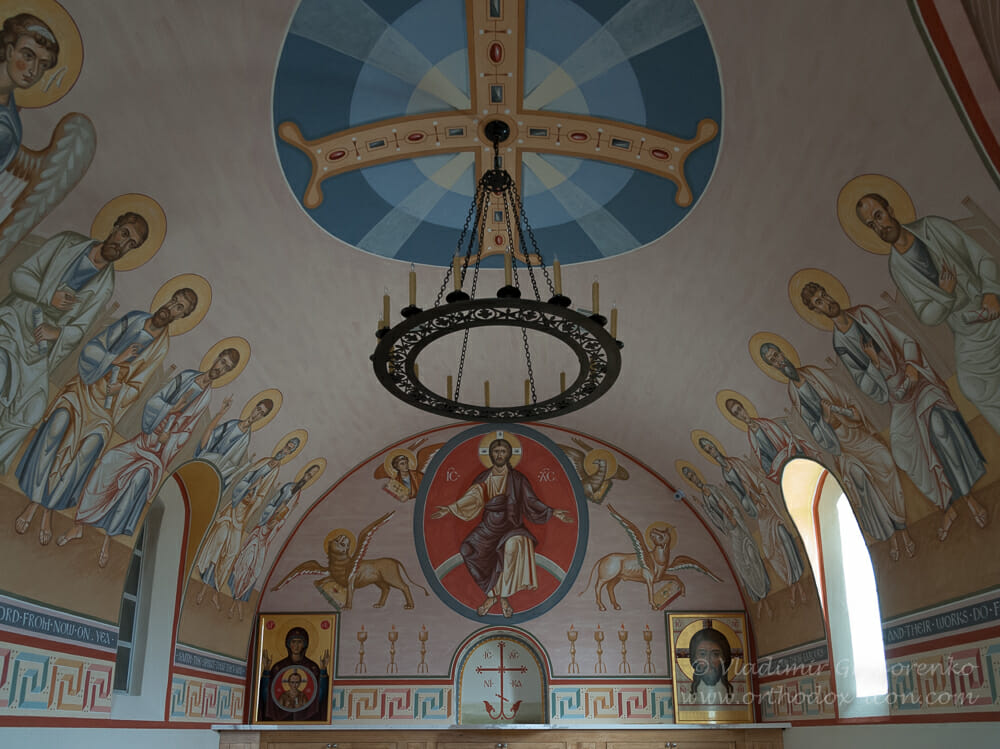
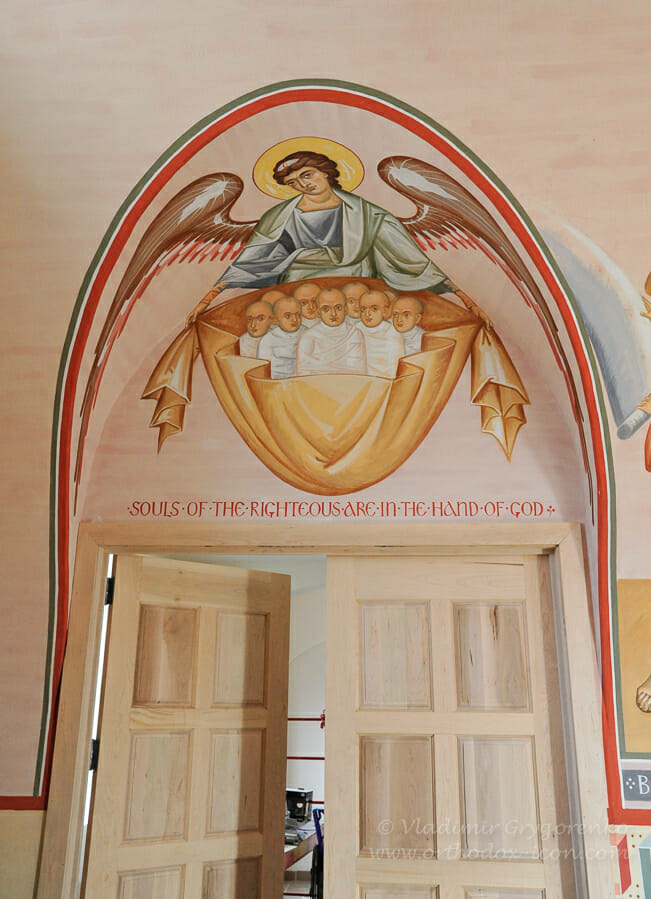
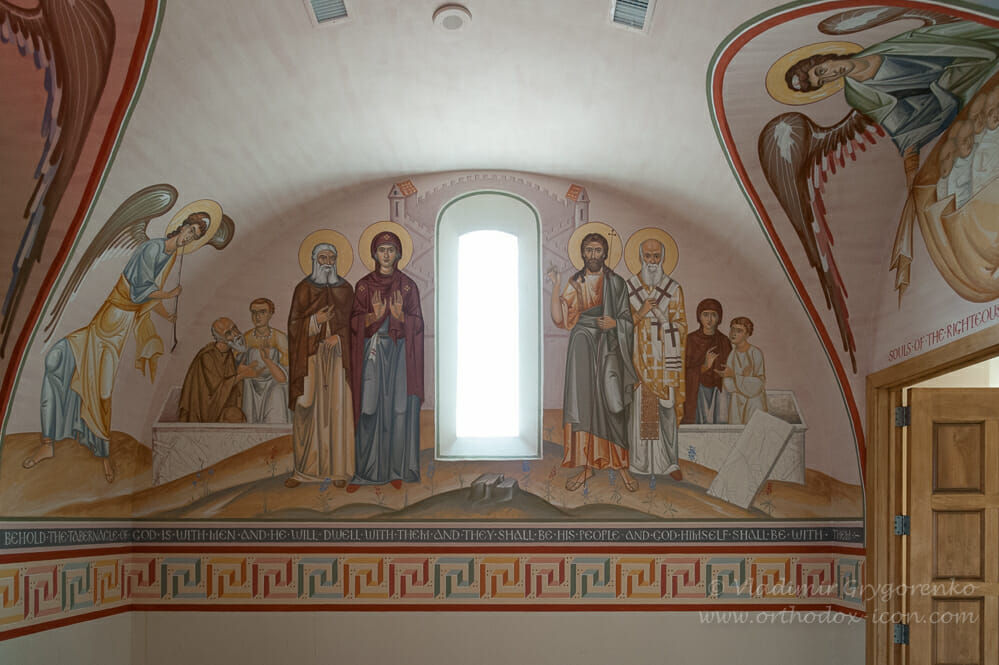
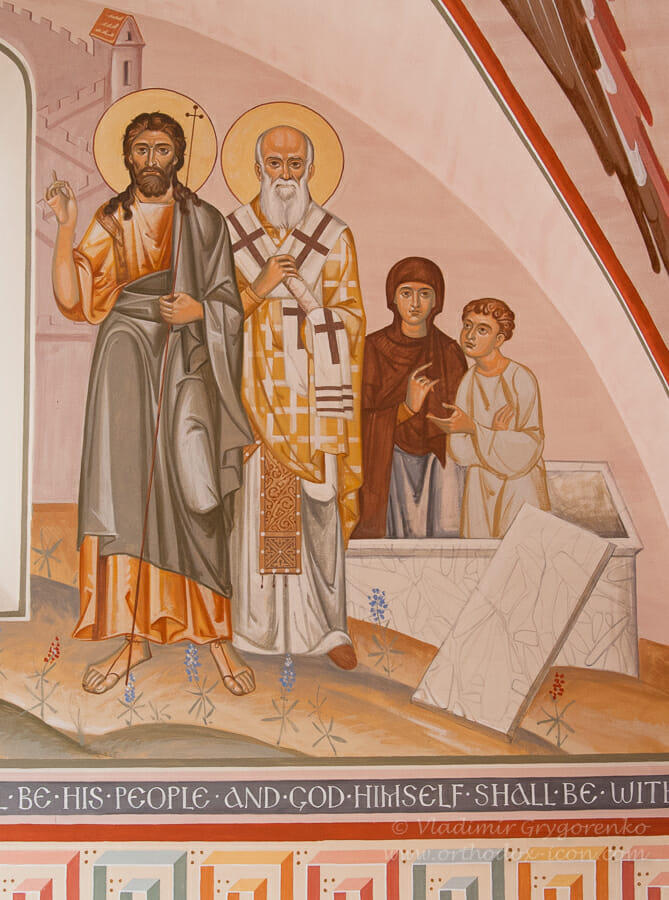
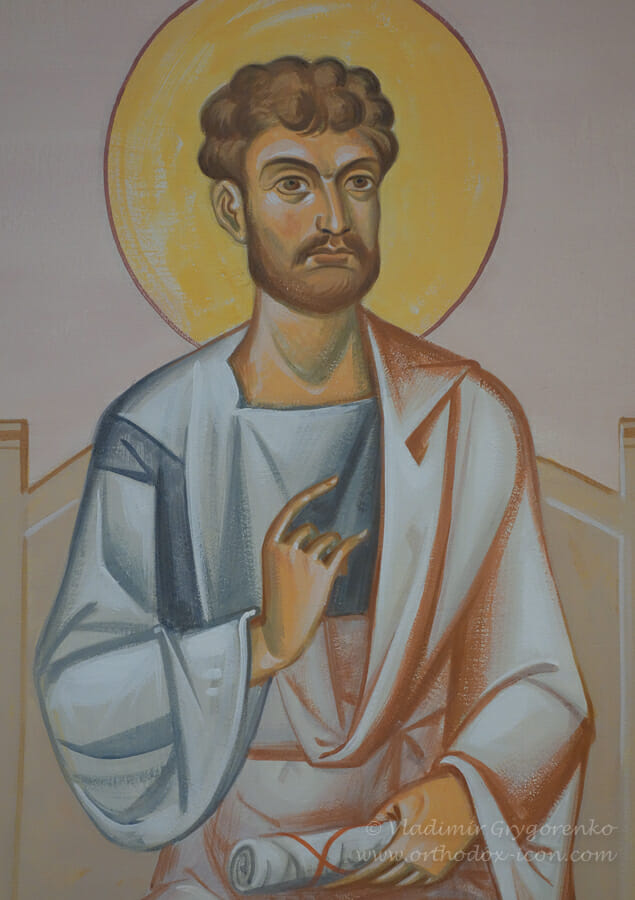
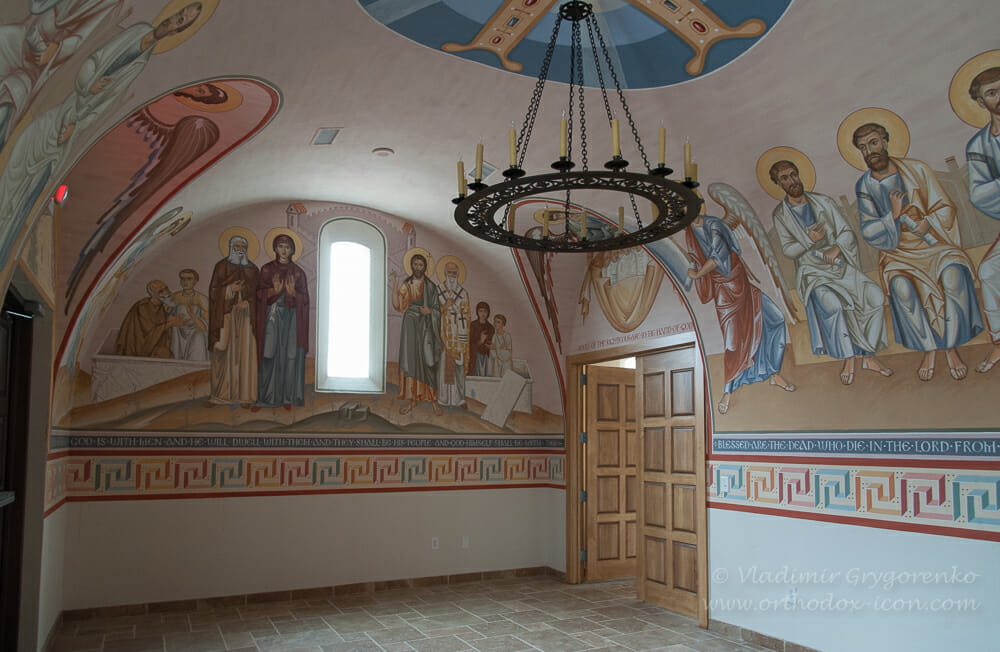
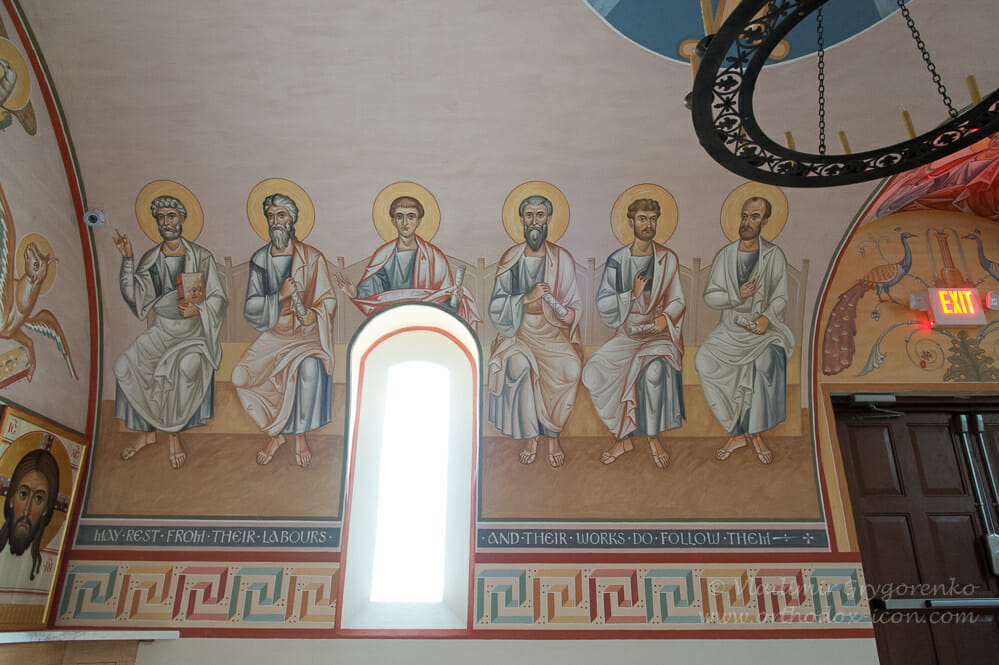
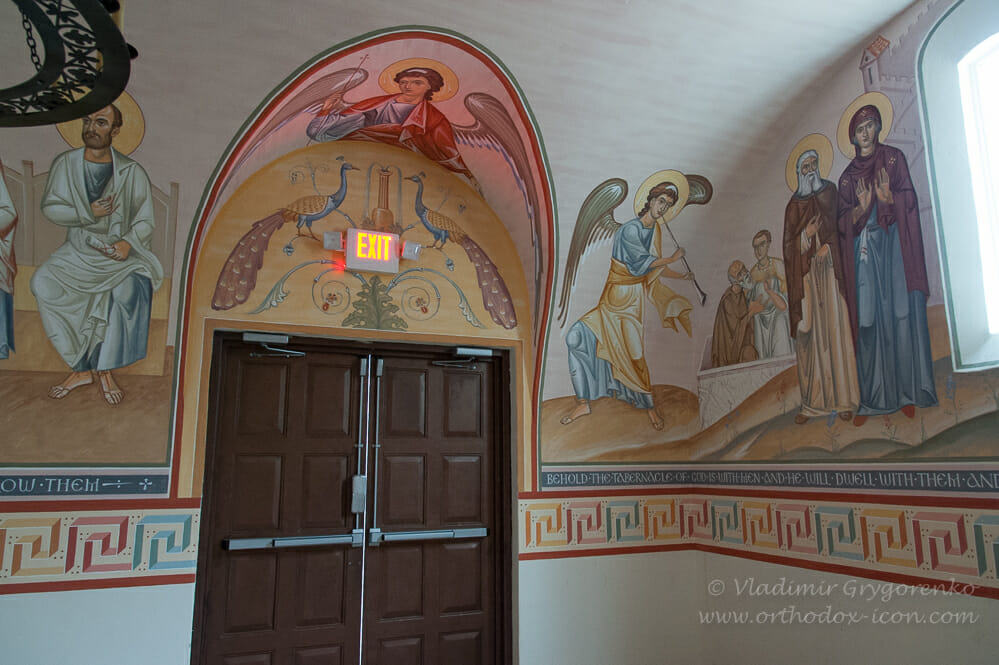
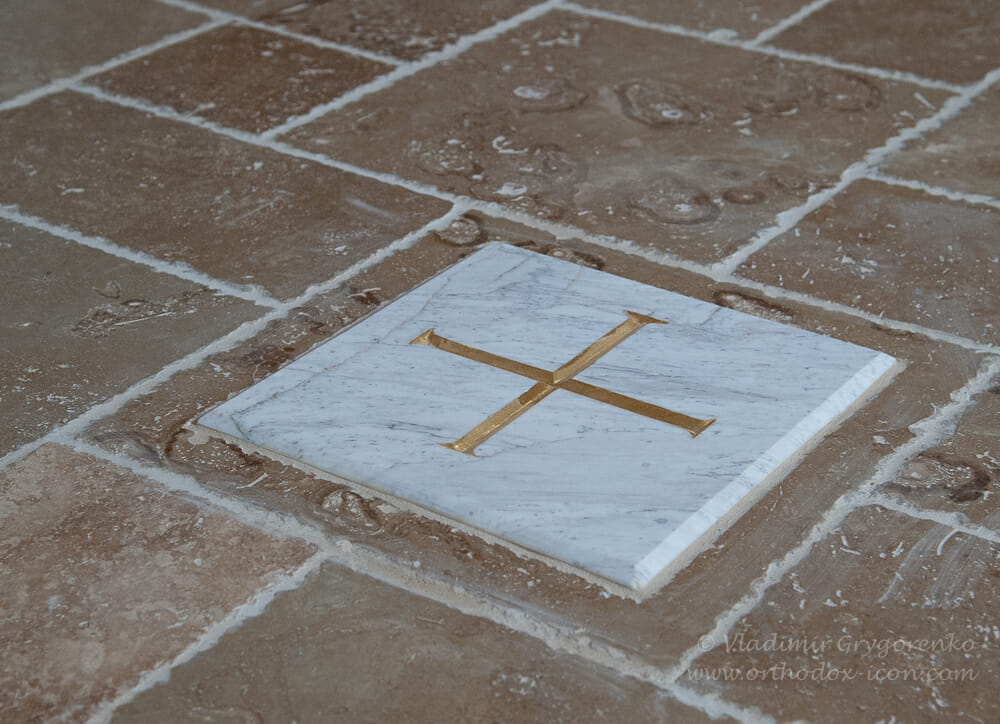
So beautiful. The boldness of the drawing is so strong and the great use of white even in the colored vestments is very successful, far more successful than the pastel colors that are sometimes used to give that impression of light. Moving from saturated color to stark white keeps strong contrast without any darkness. I am curious to the choice of not putting any of the saints’ inscription. It seems the only image with an inscription is the image of Christ. Is there a specific reason for this?
Jonathan, thank you for the great question!
You are absolutely right: Only Christ has His name inscribed in the Chapel. I did this in order to stress His unique role and place. He is the one who will give new names (Rev. 12:17 and Isaiah, 62:2) to his disciples.
And finally, most important inscriptions (besides the Name of Christ) are placed below images on the gray band around the Chapel.
These Bible passages suppose to explain and “name” the composition, in the same way as inscriptions ” Baptism” or “Annunciation” , placed in more “regular” scenes describe them.
What a wonderful interview!
May God bless Vladimir and all who made possible this beautiful monument to the glory of God and the thrice blessed memory of Archbishop Dmitri.
Your talents and abilities never cease to amaze me.
The sign of the cross on the ground intrigues me. Do we know more about this ?
Canon 73 of the sixth ecumenical council forbade the reproduction of the sign of the cross on the ground.
Thank you.
Nicolas, thank you for the question.
As it is clear from the text of the Canon 73, and especially from comments by Zonara and Aristen, the true intent of that rule is to prevent desecration of the Cross, which may happen if cross will be drawn on the floor and people will have no choice but step on it…
Besides the fact that there are many exemptions from this rule in ancient churches,(especially for gravestones), the Cross in the Chapel is carved over the marble plate which marks the future place for tomb of Archbishop Dmitri.
Obviously, nobody would step on it neither now, nor in future, where we will replace that little placeholder with larger gravestone with Vladika’s name on it…
Hope that will help.
Thank you for this precision.
Your work continues to illuminate my soul!
But I do have one question. Are those flowers growing around Archbishop Dmitri’s feet Texas bluebonnets?
Yes, Alex, you caught me red handed…. Archbishop did love them, and they start to blossom when I was finishing that mural. Besides, these flowers will greet Christ too, isn’t it?
It is so beautiful. I am wondering about the peacocks over the doorway. They are beautiful, and they fit the space perfectly. Is there some symbolic meaning, or are they pure whimsy? Whimsy is fine – they are still a wonderful creation of Our Lord!
Gale,
Picture here is rather small so it is difficult to see that these birds are actually drinking from the fountain (above the Exit sign)…. peacocks drinking from the fountain are ancient symbol of the Life Everlasting, and by themselves, are just beautiful creatures of God.